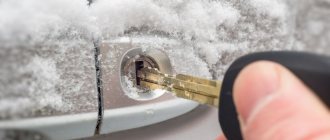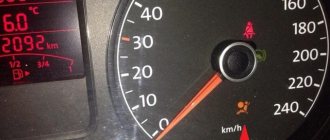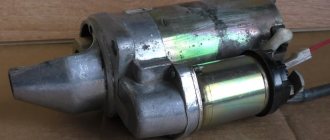Why are the candles flooded?
Let's first look at the reasons why the spark plugs on the injector are flooded. To do this, consider the operation of a car starter.
Thanks to the operation of its pistons and valves, a mixture of gasoline and air is supplied to the combustion chamber, which is ignited by a spark generated by the spark plugs. After ignition, the starter turns off. Thanks to ignition, the engine cylinders start working. To successfully start the engine, you need a working starter, a powerful battery and a favorable ambient temperature.
At low temperatures, gasoline does not mix well with air. It is known that frosty air contains more oxygen. An increase in oxygen content requires the supply of more gasoline. The vehicle's electronic control unit sends a signal to the fuel injectors, which increases the fuel supply. Thanks to the starter, compression is created in the cylinders and at the same time a spark is formed to ignite the fuel mixture. But since the compression does not meet the standards and the spark is weak, the incoming gasoline will flood the spark plugs, preventing the mixture from igniting. This is the reason why candles are poured in cold weather.
The formation of a spark is influenced by the following factors:
- Gasoline quality. It should not contain many impurities and dirt, as this will affect the operation of the injectors.
- Engine wear. If the engine pistons are worn out, they do not create the necessary pressure and fuel may flood the injector.
- Quality of candles.
- Quality of injector and carburetor.
- Battery power: You should monitor its charging.
If the compression is ideal, the engine will start even with minimal impulse and fuel fluid will never fill the injector. But only a new car can boast of such compression. If a car, for example, such as a VAZ, is more than three years old, gasoline fills the spark plugs on the injector more often.
Fills spark plugs with antifreeze
The appearance of antifreeze on the spark plugs means the same problems as the appearance of oil. The engine requires diagnostics and repair. The difference is that depressurization occurred in other places. Most often, the gasket is broken, and antifreeze gets from the cooling system into the combustion chamber.
It is better if the antifreeze immediately filled the spark plugs to such an extent that the spark disappeared and the internal combustion engine stalled. In other cases, antifreeze during engine operation can damage the piston group, cylinder head, valve system and other important components. Then the repair will be many times more expensive than timely replacement of the gasket.
What to do if the candles are flooded.
How to start a car if the engine spark plugs are flooded. In the case where the spark plugs are wet from gasoline in an injection engine, you should unscrew the spark plugs, hold them on the fire with pliers (dry them), and turn the starter without installed spark plugs for about 10 seconds to ventilate the pistons. After this, the spark plugs are tightened and, as a rule, the car starts.
How to dry the cylinders without unscrewing the spark plugs in the injector
Dry the cylinders in this order:
- The gas pedal is pressed all the way to the maximum.
- Turn the ignition key and turn the starter for about 10 seconds.
- Release the gas pedal.
If the gas pedal is pressed, the throttle valve is open, due to which air circulates and the spark plugs dry out.
In this simple way, you can start a fuel-injected car after filling the spark plugs with gasoline.
If the method of drying without dismantling the candles does not help, then you will have to dry the candles manually. Manual cleaning is better, since the electrode itself can also be quickly cleaned of carbon deposits and heated over a fire, and the gap can be checked.
Spark plugs are not expensive; those who don’t want to bother and clean them buy new ones that are appropriate for the given engine.
The service life of spark plugs is from 15 to 25 thousand kilometers.
If simple minor repairs and simple actions to eliminate this cause do not help, then it is necessary to carry out in-depth diagnostics: checking the ignition system, ignition coil, injectors, temperature sensor, Hall sensor.
The video shows a solution to the problem: why the injector does not start in cold weather.
Source
The spark plugs are flooded: what should the driver do?
Let's say the engine won't start and you are sure that the reason is the gasoline on the spark plugs. In such a situation, it is useful to know what can be done if the spark plugs are flooded, how to start the car in such conditions, etc.
Let's start with the fact that there are several available ways to dry flooded candles. To begin with, the instruction manual for many cars specifically states that if the spark plugs on an injection engine are filled with gasoline, then they need to be unscrewed using a spark plug wrench and dried. Then the engine should be cranked with the starter for about 10 seconds with the spark plugs removed. Next, the spark plugs are screwed back in, after which an attempt is made to start the internal combustion engine in normal mode.
Also, many drivers, if the spark plugs are flooded, start the engine with cylinder purging. In some cases, this method allows you to start the engine without removing the spark plugs. To purge the cylinders on an injection engine, you need to press the gas pedal all the way before starting. Next, the starter cranks the crankshaft for about 10 seconds, then the gas pedal can be released. Such actions help the power unit start. Purge occurs due to the fact that when the throttle valve is open, a large amount of air enters the cylinders, and the spark plugs dry out.
If the engine does not start with purging, then the spark plugs will have to be dried manually and their condition assessed. To do this, they need to be unscrewed, after which the carbon deposits are cleaned. You can use a soft brush (a toothbrush will do) or a brush with metal bristles. In the second case, you need to be careful and clean without effort. Candles are dried with a household or hair dryer, calcined on a gas burner, and placed in the oven. Next, you need to check the gap between the electrodes, after which you can screw the elements back into the engine. As a result, restarting should proceed without difficulty.
Let us add that many experts recommend not implementing the solutions described above if it is possible to immediately purchase new spark plugs. In simple words, cleaning and calcination leads to the fact that the service life of the spark plug after such actions is noticeably reduced, the gaps are lost, and these elements work worse after cleaning. It turns out that it is more profitable to purchase relatively inexpensive new spark plugs than to clean, dry and then reinstall the old ones. It is also noted that it is advisable to change simple spark plugs from the average price range every 15-25 thousand kilometers traveled, regardless of their condition and appearance.
It should also be taken into account that if new or cleaned spark plugs are constantly flooded, then the cause must be looked for separately, and not just solve the problem by cleaning or changing these elements. In this case, the engine needs in-depth diagnostics; the ignition system, injectors, ignition coil, Hall sensor, temperature sensor, etc. are checked.
Features of starting a car in cold periods
In cold weather, before starting, you must first load the battery, then disconnect it for a while. After waiting a few minutes, you can try turning the starter to start the engine. If you fail to start the car on the first try, then in order not to fill the injector, you must wait a few more minutes. If all preventive measures were carried out in full before the frost, then there should be no problems with filling fuel.
We can list several conditions that are considered optimal for normal operation of the injector:
- presence of a working starter;
- maximum battery charge. The battery is powerful and in good condition;
- seasonal lubricant is used;
- spark plugs and high voltage electrical circuits must be in perfect condition;
- clean, adjusted nozzles are installed;
- The gas tank is filled with high-quality fuel.
There is an opinion among experienced drivers that driving a car along a highway at a speed of 120 km/h promotes self-cleaning of automobile systems, including the fuel system. You can also run the engine at 5000 rpm for about 10 minutes in the morning. The effect is similar to racing on a track.
It is believed that when high pressure is created in the systems, self-cleaning occurs. These measures can only be carried out if the car is in good condition and a significant increase in pressure in the systems will not harm it.
What steps do you need to take to get started?
The question arises, what to do if the car is not old, all systems are in order, but in the cold it refuses to start? When turning the spark plugs out, it turns out that they are wet. As already mentioned, in the cold season, the cause of this phenomenon may be weak compression, low-quality fuel or a weak battery.
Let's look again at the manufacturer's instructions. The book on car operation defines the following algorithm of actions:
- Turn out the spark plugs.
- Wipe them thoroughly and dry them.
- Run the starter for a few seconds.
- Put everything in place.
Often, car owners clean the injector using various fuel additives. This is not recommended at all, firstly, the quality of the fuel mixture is lost, which negatively affects the operation of the entire piston group, and secondly, the injector should be cleaned using special equipment.
Experienced drivers carry several sets of spare spark plugs with them. The quality of the spark produced depends on the technical characteristics of this ignition component. There is no point in saving on candles, their cost is not that high, and low-quality candles can cause a lot of problems.
How to act to avoid trouble
- firstly, you need to monitor the battery charge level and check it periodically (this is especially true in winter);
- secondly, check the serviceability and if any problems arise, do not be lazy to go for diagnostics;
- thirdly, only the best quality, which is suitable for use in winter;
- fourthly, promptly change and inspect high-voltage wires for the fact of their probable failure;
- fifthly, regulate and. This is easy to do - add one of the special compounds that are sold in stores to the tank;
- Sixth, use high quality. To do this, refuel at trusted gas stations.
Remember that in the cold season the engine does not like small trips at low speed.
Hello, dear car enthusiasts! Maybe not all, but many motorists are faced with this problem: yesterday I arrived, put the car in the garage, everything was fine. This morning I started to start the engine, but it would not start.
There could be a number of reasons for this
But today we will look at the most common one - filling the spark plugs with gasoline, it doesn’t matter whether you have an injector or a carburetor. Fills spark plugs with gasoline regardless of the type of vehicle fuel system
It is characteristic that the spark plugs are filled with gasoline less often in the warm season, and more often at sub-zero temperatures. So let’s try to figure out in order: why the spark plugs in the injector are flooded, what to do to start the engine at the exact moment when they are flooded, and how to prevent them from being flooded with gasoline in the injector.
Reasons why the spark plugs in the injector flood
In principle, the reason why the injector spark plugs flood is simple. And the tones lie in the peculiarities of the “electronic brain” of your car.
At subzero temperatures, mixing the fuel-air mixture requires some effort: more oxygen in cold air requires more gasoline. Accordingly, the ECU gives a command to the injector nozzles to increase the fuel supply, which they do in good faith.
And the following happens in the engine, especially if your car no longer has a new battery. The injectors supply fuel to the combustion chamber, the starter tries to create the necessary compression in the cylinders, while at the same time trying to provide a spark to generate a flash. Do not forget about the quality of fuel, which does not have ideal parameters.
As a result, with ideal compression, the injector spark plugs can start even with a minimum impulse, but ideal compression is only found in a new car. Actually, this is why, as a rule, the injector spark plugs of a new car do not fill.
The spark is weak, compression in the cold does not correspond to the parameters, and the injectors continue to supply fuel to the combustion chamber. Which, in turn, floods the candles and they simply stop showing signs of fiery life.
This is the answer to the question - why are they filled in on the injector?
There are two options for resolving the issue. As a rule, the “smart” operating book says: if the injector spark plugs are filled with gasoline, you need to unscrew them and dry them. With the spark plugs removed, crank the starter for 10-15 seconds. Put it back in and start the engine. These are actions according to the manufacturer.
A proven popular driving method. If your spark plugs are filled with gasoline, before unscrewing and drying them, try to start the engine in the following way: purge mode.
For the injector: the gas pedal is pressed all the way to the floor. Use the starter to crank the engine for 10-12 seconds, release the gas pedal. The engine should start. The fact is that in this way, by cutting off the fuel supply, you blow air through the spark plugs.
The engine did not start. Then try to dry them. Spark plugs for an injector are, in principle, no different from a carburetor engine. Therefore, we again use the “old-fashioned” method: we unscrew them, clean them from carbon deposits with a metal brush, or a toothbrush, and dry them either with a hairdryer, or on a gas stove or in the oven. We check the gap and screw the spark plugs for the injector into place. The engine should start.
If the story of filling the spark plugs with gasoline repeats itself every morning, you need to carry out diagnostics: spark plug quality, injector cleanliness, spark output from the ignition coil, Hall sensor.
The spark plugs are filled with gasoline, what should I do?
There are several options to correct the situation: the simplest is to unscrew the spark plugs from the engine and dry them. After removing the spark plugs, you need to turn the key in the ignition switch so that the starter spins for about 15 seconds, after which you can put the dried spark plugs back in and turn on the engine. This is what the car manufacturer recommends and writes in the operating instructions.
You may also be interested in: Do-it-yourself car body repair before painting
But there is another proven method - if the spark plugs are filled with gasoline, then before unscrewing the spark plugs and starting to dry them, you should try to start the engine using the purge mode.
To turn on this mode, in a fuel-injected car you need to press the gas pedal to the floor and turn the key in the same way so that the starter spins for about 12 seconds, after which you need to take your foot off the gas pedal, and the starter should continue to spin. The engine should start at this moment, after releasing the gas pedal.
It turns out that when you turn off the fuel supply, the spark plugs are blown out with air. If after such manipulation the engine still does not start, then you need to dry the spark plugs. Injection spark plugs are no different from carburetor spark plugs, so you can safely do the same as they have been doing for centuries - they unscrewed the spark plugs, cleaned them of carbon deposits with a metal brush, and therefore dried them with a hairdryer or gas stove. After drying, you can check the gaps and screw the spark plugs back in. After this, the engine should definitely start.
To prevent this situation from occurring frequently, you need to periodically clean the spark plugs or change them on time. If you fill the spark plugs on an injection engine with gasoline every time when they are cold, this means that you need to do diagnostics - check whether the spark plugs, ignition coils, high-voltage wires, injectors and Hall sensor are normal. If all these components are normal, then the question of whether the injector can fill the spark plugs will disappear by itself.
Why does it flood the candles when it’s cold?
If the spark plugs become wet in the summer, the car will start. And if it’s flooded in winter, it usually won’t start.
Signs of flooded candles are:
- The starter turns the crankshaft, but the engine still doesn’t want to start.
- When you try to start the car for a long time and the engine does not start, there is a strong smell of gasoline coming from the muffler.
- When dismantling a flooded spark plug, its thread and electrode are wet, and there is dark carbon deposits at the bottom of the spark plug, where the spark is produced.
Fills spark plugs on both injection and carburetor engines. Injection engines are flooded less frequently than engines with carburetors. If contactless ignition is installed, then it can still contribute to the production of a spark in the candle, because contact converts energy up to 18 kilovolts, and contactless electronic up to 24 kilovolts.
If the fuel-air mixture in the cylinder misses ignition, there is a lot of it, as a result of which the fuel mixture is not able to ignite in subsequent cycles.
Reasons for flooding spark plugs of injection and carburetor engines:
- Insufficient battery charge. Sealed, maintenance-free batteries must be charged according to strict rules. Low battery charge is the reason for flooded spark plugs, mainly in injection engines, since the injector and a bunch of stuffed electronics consume a lot of energy resources, a powerful battery is needed.
- There is a problem with the ignition system. This is either broken spark plugs or high-voltage wires. Old spark plugs may produce an infrequent spark or a misfire if the tip gap is not within normal range. High-voltage wires are also often punctured if they are of poor quality.
- Gasoline is of very low quality. Nowadays, private gas stations are common; it is enough to obtain the appropriate permits and start selling fuel. As a rule, no one checks the quality. Therefore, you should refuel at reputable large gas stations. Due to bad gasoline, condensation collects in the fuel system. Problems with starting a car in the cold season with low-quality fuel are especially noticeable.
The electronic control unit of the injection engine determines the outside temperature and the engine temperature, determines the oxygen content of the air flow entering the engine. Next, the control unit sends a signal to the injectors to increase the supply of injected fuel, which helps create a rich fuel-air mixture for reliable engine starting in cold weather.
Cars with high mileage have a certain wear of parts of the cylinder-piston group; compression in the cylinders, accordingly, becomes less, but within acceptable limits. With low compression, when the spark plugs are flooded, it is more difficult for the engine to start. With high compression, if the spark plugs are working, the fuel-air mixture can still ignite, even if the fuel is not of high quality.
Low compression, thick engine oil, weak battery - all this makes it difficult to start the engine. The following happens:
- low quality fuel is supplied;
- the crankshaft rotates slowly due to engine oil thickened by frost, the battery is not charged enough;
- due to the fact that the engine is cold, the compression in it is lower than in a heated state;
- generation of a weak unstable spark.
In order to fill the spark plugs, you just need to try to start a car with a weak battery.
The main reasons for poor starting
The list of reasons why a cold engine is difficult to start is quite wide. Before starting diagnostics, it is necessary to more accurately localize the fault. Make sure the battery is charged and the starter turns the engine smoothly (at the same speed). Additionally, it is worth excluding the possibility of refueling with low-grade gasoline.
Fuel supply
Problems with starting the engine can arise both as a result of the fact that there is no fuel supply, and due to failures in the process of its ignition in the engine cylinders. As for the fuel supply, there may be too little fuel to start. It is also possible that the spark plugs are flooded with excess fuel.
- It's worth starting the check by making sure there is an exhaust. If light smoke appears from the exhaust pipe after turning the starter, then this indicates that there is fuel supply to the cylinders.
- The next step is to remove the spark plugs. The spark plugs must be unscrewed after an unsuccessful attempt to start the engine. If the spark plug is flooded with gasoline, then this can often indicate problems with injector sealing or ignition. Check the integrity of the spark plugs themselves and the high-voltage wires, and also make sure that there is a spark at the spark plugs. A dry spark plug will indicate that fuel is not being supplied to the cylinder.
- Clogged coarse and fine filters, as well as faulty or heavily coked injection nozzles, can also hinder the normal supply of fuel to the engine. Fuel may also not enter the engine due to a sharp decrease in the performance of the fuel pump. This means that the fuel pump is not creating the required pressure. To find out the reasons, you will need to check the fuel pressure in the rail and the fuel pump itself.
Electronic sensors
The electronic injection system is equipped with special sensors, thanks to which interaction with the engine ECU is realized. Failure of individual electronic components can result in incorrect signals being sent to the control unit and the engine cannot be started.
If the engine does not start, then you need to check several sensors:
Ignition check
The engine may not start if the ignition distributor is faulty. This malfunction manifests itself in such a way that when the starter rotates, the so-called seizure does not occur, that is, there are no signs of single attempts to ignite the fuel-air mixture in the engine cylinders.
It is also worth paying attention to the setting of the ignition timing, timing belt and its drive. In some cases, it is worth checking the condition of the variable valve timing system (if equipped)
The ignition coil can be checked using a multimeter.
Compression reduction
A loss of compression in one or more engine cylinders is a consequence of natural wear or damage to the power unit. A motor with low compression does not, as there is a strong increase in the gaps between the parts in the cylinder. In other words, it is not possible to achieve the required pressure in the combustion chamber to ignite the working mixture at the time of start-up.
Frequent causes of this malfunction may be piston destruction, broken or stuck piston rings, burnout of the timing valve, wear of the cylinder walls, etc. Low compression most often appears during a cold start, but can also be present constantly (when trying to start a very worn engine “hot”). An engine with such a malfunction is most difficult to start at low temperatures. For an accurate diagnosis, compression must be measured.
Why does the starter turn normally, but the engine does not catch and does not start? Main causes of malfunction, checking fuel supply and ignition systems. Adviсe.
Why the engine may not start at low temperatures: possible causes and malfunctions. How to properly start a frozen engine after parking.
Why spark plugs flood on injection and carburetor engines: the main reasons for wet spark plugs. How to dry spark plugs and start the engine, tips.
Why does the engine smoke black after starting? Causes of white smoke or blue exhaust gases. Diagnostics of faults, recommendations.
Causes of difficult “cold” starting of a diesel engine. Compression, glow plugs, diesel injectors, injection pump, paraffin or water in the fuel system.
Starting a diesel engine in winter. Antigel additives for diesel fuel, kerosene and replacing the fuel filter. Heating of the fuel tank, glow plugs, battery.
Spark present
If you are familiar with the situation when there is a spark, but the spark plugs are flooded, and the crankshaft rotates well from the starter. Here it is necessary to check the spark plugs themselves, despite the fact that there is a spark. This may not mean that it will always happen under pressure. Simply put, the spark will be on the unscrewed spark plug, but it may disappear after it is installed on the power unit. What causes this? In this case, the reason for this is the increase in pressure created during operation of the internal combustion engine. The best way to determine this is through diagnostics on a special stand.
You should also pay attention to the gas distribution phases. Often their failure, various interruptions, lead to flooding of spark plugs. Injection engines can also have problems with bypass valves. Eliminating the likelihood of such problems is possible by measuring the fuel pressure in the rail. Do not forget that fuel enters the cylinders under the influence of a certain pressure. If there are deviations in any direction, flooding of the spark plugs is inevitable, which prevents the engine from starting.
Diagnostics is also important for injectors and ECM sensors directly. How does this manifest itself? It's simple, the temperature sensor, having detected a malfunction, sends incorrect data to the control unit. As a result, the ECU saturates the mixture and the fuel is poured into the injectors. Sometimes the power unit control unit itself may break down.
What are they doing to prevent this from happening?
The most important thing in this case is to ensure the proper technical condition of the engine systems
First of all, pay attention to the condition of the battery. Topping up with distilled water doesn't end there.
It should be charged and the charge level checked regularly. For areas with low temperatures in winter, the use of insulated battery covers is recommended. They can be purchased at automotive stores or made yourself. In very severe frosts, it is best to remove the battery from the car and bring it into a warm room.
Battery cover to keep the battery charged in cold weather.
The starter must be in perfect condition. If there are problems in it, then even with a fully charged battery it is impossible to start the engine. The battery's energy will be taken by a faulty starter, so it will not be enough to produce a high-quality spark.
On used injection engines, you need to regularly clean the injectors. Experts do not recommend performing surgery using additives added to gasoline. The desired effect is obtained after using the appropriate equipment, which some craftsmen make themselves.
Finally, I would like to give advice from experienced drivers. Periodically clean the spark plugs by driving at high speeds. It is enough to drive a certain distance at a speed of 110-120 km/h for self-cleaning to occur.
Possible solutions to the problem of flooded candles
The manufacturing plant has already foreseen the situation in which the spark plugs splash, and VAZ, for example, has the corresponding instructions in its passport. Basic recommendations for actions if fuel gets on the spark plug, which is called “cold”:
- Remove the candles.
- Crank the starter for 15 minutes without spark plugs.
- Wipe and dry the spark plugs well, then install them in their original place.
There is an alternative, so-called “folk” method. It must be applied even before the spark plugs are removed:
- Press the gas pedal all the way.
- Crank the starter for 10 -15 seconds.
- Return the pedal to its place.
Since at this moment there is no supply of fuel mixture, the spark plugs are purged and dried with air. If all else fails, remove the wet spark plugs and dry them thoroughly. Depending on the conditions, you can dry it over any heat source - fire, gas stove, hairdryer.
Injection and carburetor spark plugs are practically the same, so the methods used can be used in both cases. If the spark plugs on the injector are flooded in the warm season, diagnostics of the fuel system and the sparking mechanism is necessary. If necessary, it is necessary to replace faulty components. At the same time, the condition of the injectors is checked, as well as the functionality of the Hall sensor.
The main reasons why spark plugs flood lie in non-compliance with the terms of preventive maintenance and technical regulations. Prevention can significantly increase the period of trouble-free operation of vehicle components. Therefore, even before the onset of frost, a number of preventive measures should be carried out:
Constantly monitor the condition of the battery. In winter, it is generally better to install a battery with a higher capacity than was used in the warm season. With a powerful battery, a number of reasons for allowing fuel to flood the spark plugs disappear
It is best to recharge the battery at night, but in compliance with fire safety rules; During cold weather, increased attention must be paid to engine oil, and high-quality gasoline should also be filled, without contaminants. Consumable lubricants must be appropriate for the season; You must constantly monitor the condition of the spark plugs
It is necessary to regularly unscrew the spark plugs, remove carbon deposits from them, clean and adjust the gap. If technical characteristics deteriorate, it is best to replace the spark plugs.
Causes of oil on spark plugs
If the candles are covered with oil, then first of all it is necessary to determine exactly which part has the most of it. Many car owners are faced with a situation where only the threads and body are coated with lubricant, while the electrodes are dry and have a normal color (light brown). But it also happens that the entire base ends up in oil.
At the same time, in addition to traces of lubricant on the spark plugs, a malfunction with the engine manifests itself in other ways - deterioration in dynamics, increased exhaust smoke, oil burns. In order for it not to be the cause, it must be eliminated.
Most often, the appearance of grease marks occurs due to wear and damage:
Studying plaque on candles
They say that when candles are “flooded,” black soot forms. Let us clarify: it should not consist of inclusions. All metal, in turn, will be covered with an oily coating. Dry carbon looks different...
Oily layer and dry soot
We recommend: How to glue moldings on car doors?
The photo shows two cases. “Our version” is on the right.
And soot can also be brown. And it always, in 100% of cases, is formed due to flooding with gasoline.
Dark brown soot
An oily coating, as in photo 1, is, nevertheless, the result of oil ingress. But an oiled candle does not work correctly - it will also be “flooded”.
With regular “flooding,” carbon deposits form, which we see in photo 1 on the right and in photo 2. The rest does not apply to our case.
Why does fuel flood the spark plugs in the injector?
If the spark plugs are flooded, then among the reasons, the condition of the piston system should be put in first place, because with ideal compression, the engine should start even with minimal spark values. However, only a new car can have such compression, while a used car already has some wear and tear. After only three years of operation, a VAZ car begins to suffer from this disease when fuel enters the injector.
It is typical that fuel can get onto the spark plugs in winter even in serviceable cars as a result of the system’s interaction with cold air. But in the summer, this problem in the vast majority of cases occurs if something is wrong with the car. The ignition control unit malfunctions - when a command is given to increase the fuel in the injectors, the fuel supplied in a large volume does not have time to ignite, hence wet spark plugs and other troubles. This applies to injection engines; for carburetor cars, in the absence of an ECU unit, this situation arises due to insufficient compression, and this directly depends on the condition of the piston group.
It is worth mentioning another problem when the spark plugs are stained with oil and the engine operation is inconsistent. There is an increased waste of expensive oil, problems with idling and “triple” of the engine. Among the reasons, we can name, first of all, the same wear of the piston group, increased oil pressure in the crankcase, failure of the valve stem seals and cuffs.
Seven reasons to fill candles when cold
If you decided to start the engine, but nothing happened, and instead you found spark plugs stained with gasoline, then this could happen for the following reasons:
1. Insufficiently charged battery. Even if at positive temperatures the battery coped with its tasks without problems, the onset of frost could radically change the situation. It is enough for the battery to be discharged by 50%. Even with this indicator, there may not be enough power to start the engine.
2. Cylinder wear. A worn-out engine cannot run perfectly, so it is not surprising that new engines have insufficient cylinder compression. In combination with other factors, this can lead to flooded candles.
Compression measurement
3. Old spark plugs. It is not for nothing that this part is consumable and requires regular monitoring and, if necessary, replacement. If you do not change the spark plugs for a long time, then defects appear on them, which can prevent spark formation, which is so necessary to start the engine.
4. Malfunction of structural elements of the ignition system. Faulty wires and soured contacts can be one of the reasons that caused spark plugs to flood.
5. Poor quality fuel. This does not mean that you were deceived and sold bad gasoline. The point is that in winter there are a number of factors that can negatively affect the quality of fuel.
For example, the formation of condensation in the fuel tank and its entry into gasoline. As a result, the fuel does not ignite at the right time, which becomes one of the reasons for “wet” spark plugs.
6. Unsuitable engine oil. If we are talking about winter, then you need to use oil with a viscosity that will not load the engine, otherwise this will become another factor creating conditions for flooding.
7. Accumulation of carbon deposits in the combustion chamber. Short trips in the city do not allow the engine to “breathe”. As a result, carbon deposits form, which settles in a thick layer on the walls of the combustion chamber. The mobility of the piston rings decreases, and with it the compression in the cylinders. As a preventative measure, it is necessary to run the engine at high speeds. Sometimes, to return the piston rings to mobility, special flushing of the system is required.
Carbon deposits in the combustion chamber
Sometimes it happens that there is a spark and the starter rotates normally, but gasoline still pours out. In this case, it is necessary to carry out diagnostics to determine the serviceability of the spark plugs. In rare cases, the problem may be in the ECU itself.
Possible causes of malfunction
The reason for this trouble could be:
- The spark plugs failed because they had outlived their useful life. It is recommended to change this consumable part after approximately 7-10 thousand kilometers traveled. If this was not done, then it’s time to buy new ones and the problem will disappear.
- Wear of the cylinders, in this case, compression drops and the engine stops working normally, which also leads to spark plug flooding.
Measuring with a compression meter will help you verify this version.
- Low battery. When temperatures change, there is a possibility of loss of charge, and a lack of power leads to the engine refusing to start, as a result of which the spark plugs may flood.
- Soured wires or contacts connecting structural elements. If such a malfunction is detected, it is recommended to clean them with a special liquid or replace them.
- Condensation in the gas tank. This is also a common problem that motorists face during the winter season. The accumulated condensate mixes with gasoline, and this prevents it from igniting when necessary.
You can prevent this type of problem by purchasing a fuel additive and using it following the instructions.
- The consistency of the oil is not suitable for the cold season.
Important. Before the onset of cold weather, change the engine oil to a higher quality one. It will not thicken in the cold and interfere with the full operation of the engine.
- Carbon deposits in the engine. The driver needs to remember how long ago the engine was cleaned from carbon deposits. Possibly accumulated dirt deposited in thick layers in the combustion chamber reduces the mobility of the piston rings, which can lead to disruption of the process and serve as a reason for filling.
Fuel supply and sparking process
When negative temperatures set in, the fuel mixture becomes insufficiently saturated with air; this occurs as a result of an increase in oxygen in the air during frost. Increased oxygen concentration requires increased fuel supply. If the electronic control is in order, then the corresponding command is sent to the injectors and the fuel supply is normalized in accordance with the temperature regime.
When starting, the starter creates compression in the cylinders while simultaneously producing a spark at the spark plug. As a result, the fuel mixture ignites and the engine performs a power stroke.
If the compression is weak and sparking is insufficient, the fuel mixture does not have time to ignite and simply gets on the spark plugs, then starting the car becomes problematic.
Factors influencing normal sparking:
- quality of the fuel mixture. The presence of dirt and large amounts of impurities negatively affects the functioning of the injectors. They simply become clogged with dirty fuel;
- engine condition. Wear of the pistons does not make it possible to create the necessary pressure in the combustion chamber, so fuel, not finding an outlet, begins to flood the injector;
- non-standard or low-quality candles;
- condition of the carburetor and injector;
- battery charge state. A dead battery cannot crank the starter.
Causes of the problem and a set of solutions
If the spark plugs are actually filled with gasoline when starting the engine, then you need to check how well the spark is being formed in the engine. You may have to unscrew each of the spark plugs sequentially, after first removing the high-voltage connectors. The ignition must be turned off. It is advisable to disconnect one of the battery terminals too.
Use a spanner for dismantlingWhat to check:
- There should be no carbon deposits on the spark plug contacts;
- The distance between the contacts must correspond to the “passport value”.
The bad news is that the cause of unstable spark formation can be poor quality wiring or any malfunction in the ignition control system. Sometimes finding the causes takes longer than eliminating the defect. In such cases, it is difficult to do without the help of professionals. Don't overestimate your strength.
By the way, you can try to reason logically. The controller regulates the concentration of the mixture based on air temperature values. And these values are determined according to the readings of a single sensor - DTOZH.
Any temperature sensor is a thermistor
We are, of course, talking about the coolant temperature sensor.
Note that in modern engines, to calculate the mixture concentration, not one temperature sensor is used, but several. An air heating sensor installed in the intake manifold can also be used. But the presence of engine oil in the manifold is not uncommon. And imagine what will happen if liquid gets on the body of such a sensor.











